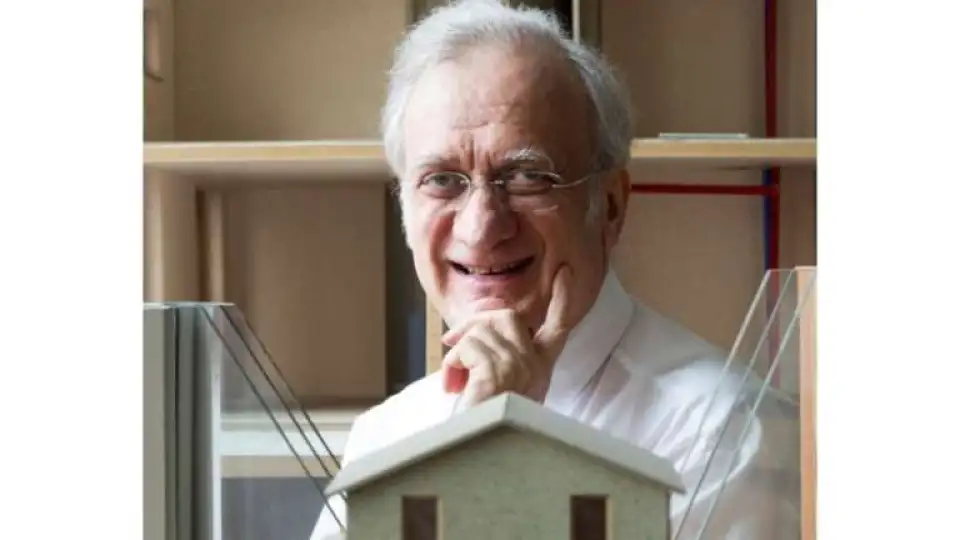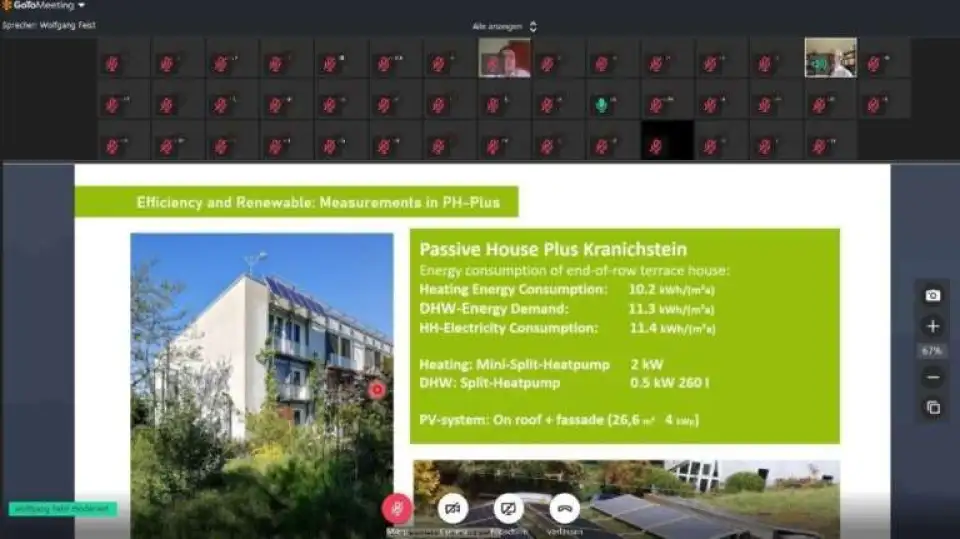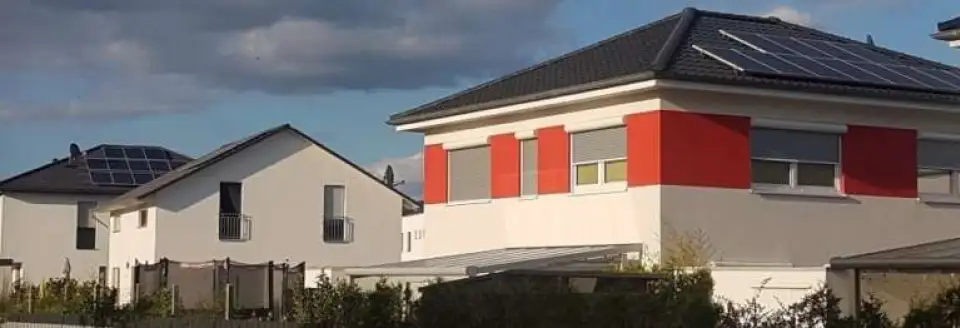
Darmstadt, Germany. Professor Wolfgang Feist opened with a clear message: “We can still halt the climate crisis. To do so, we need to make the right decisions now and then act upon them.” The founder of the Passive House Institute also highlighted the parallels between the COVID-19 and the climate crises. In addition, Feist explained how improved energy efficiency in buildings and a significant change in the areas of mobility and energy could limit the extent of dangerous climate change. “Business as usual is not an option.”
In his press conferences, organized by the Passive House Institute in cooperation with the International Passive House Association, Professor Feist addressed the international press and made it clear that climate change is a certainty: “The CO2 which will lead to increased temperatures in the next few decades was already emitted decades ago.” Just like the COVID-19 virus, the symptoms of the climate crisis only become apparent after some time. However, unlike the Corona crisis in which “just” four or five percent of the population are seriously affected, the climate crisis will negatively affect more than 60 percent of the population and put the entire human civilization at risk, Feist explained.
“Avoid the most disastrous effects!”
“We cannot change the past, but we can change the future! That is why we must act now so that the most disastrous effects can still be avoided. It will be hard work, but we can still do it!” Feist noted the fact that the primary energy demand has decreased in Germany where there has been significant growth in the economic output since 1990, even though there has been a considerable increase in air travel and total kilometres travelled. “This is primarily the result of improved efficiency, and this must be communicated.”
Expansion of renewable energy use
Feist considers energy efficient buildings and renewable energy generation a perfect combination. “If the buildings consume very little energy, then this low energy demand can easily be met through renewable energy.” Feist supported the strengthening of this positive development, among other things with more widespread use of renewable energy. The largest share of energy is used for heating buildings and for transport. “For this reason, switching from combustion motors to electric traction and energy efficient buildings is a crucial part of solutions for more climate protection.” He was also supportive of the EU’s European Green Deal “Obviously the EU understands that there is also a huge economic potential in climate protection and the change towards a sustainable society. This is a great opportunity for Europe!” said Feist.
Five principles guide efficient construction
Using the example of the world’s first Passive House building in Darmstadt-Kranichstein, Germany, the physicist showed how drastically the demand for heating energy decreases in a Passive House building. Guided by the five principles – excellent insulation, high-quality windows, an airtight building envelope that avoids thermal bridges and a ventilation system with heat recovery – a Passive House building needs only very little energy for heating in winter.

Less energy is needed
The founder of the Passive House Institute developed the Passive House standard in the late 1980s, and in 1991, he and his family built the world’s first Passive House building in Darmstadt. Monitoring of this property have proven that this Passive House, with an annual heating demand of 8.4 kWh per square metre, consumes around 87 percent less energy than a conventional building. This remains true even after more than 25 years. “That speaks for the durability of the components, which has also been proven in a study ‚” says Feist. Four years ago, the pilot project was retrofitted with a mini split heat pump for heating and cooling, and a photovoltaic system. In the balance, the world’s first Passive House produces more energy over a year than it consumes.
Heat recovery is essential
Misconceptions still abound regarding ventilation systems with heat recovery, because they allegedly consume a lot of power. “The use of 10 or 20 watts for the ventilation system which brings fresh and preheated air into the house is only a fraction of the amount of energy which must be supplied again if air exchange takes place without heat recovery. That’s several hundred watts”, explained Feist. Ventilation systems provide consistent temperatures and fresh air, also contributing to a high level of comfort.

Benefits of a ventilation system
One of the questions coming from the international participants of the press conference was whether a ventilation system offers any benefits in times of COVID-19. The answer from Feist was a resounding “Yes!” To explain: A ventilation system with heat recovery brings fresh, hygienically clean air into the home: this is not recirculated air, which has been the cause of concern to some. In addition, the systems certified for Passive House buildings are generally equipped with a highly efficient fine dust filter. “That keeps away significantly more germs than a conventional face mask. Passive House buildings are thus also good for health!” asserted Feist.
Building the future sustainably
It is generally accepted that for a climate-neutral building stock, the rate of retrofitting has to be increased. Feist cited an apartment building in Nuremberg, Germany, which was retrofitted using Passive House components according to the EnerPHit Standard developed by the Passive House Institute. “Subsequently, the renovated apartments had a heating demand of just 25 kWh/(m² a) instead of the previous heating demand of 200 kWh/(m² a). If more materials from renewable sources are used, then the future will be built sustainably,” says Feist.
Implementable in all climates
He further explained that the Passive House standard can be implemented in all climates. In this regard, the cooperation of large countries such as China is absolutely necessary. It is good news that entire districts are currently being built to the Passive House Standard in China, including the Bahnstadt in Gaobeidian which has more than a million square metres of certified Passive House living space.
Grey energy
Regarding grey energy, Feist referred to the fact that the greatest share of energy consumption is not caused by building materials but rather the operational energy demand, incurred during building use. “Energy efficient buildings are a key factor. And, of course, they can be realized with sustainable building materials. This is proven by several wooden Passive House buildings.” said Feist.
Passive House Open Days
A good opportunity to visit Passive House buildings are the mid-year Passive House Open Days, which currently offer several interesting videos from the inhabitants.
General Information
Passive House buildings
With the Passive House concept the heat loss that typically takes place in buildings through the walls, roof and windows is drastically reduced: among other things due to high-quality thermal insulation, an airtight building envelope and windows with triple glazing. The five basic Passive House principles allow these highly energy efficient buildings to dispense with classic building heating. Such buildings are called “passive houses” because a major part of their heating demand is met through “passive” sources such as solar radiation or the heat emitted by occupants and technical appliances.
Because the heat stays inside the house, active heating is needed only during extremely cold days and only a small amount of energy is required for providing this remaining heating. A Passive House building also offers an advantage in the summer: the excellent level of insulation ensures that the heat stays outside, therefore active cooling usually isn’t necessary in residential buildings. Due to the low energy costs in Passive House buildings, the utility costs are predictable — a basis for affordable homes and social housing. A Passive House building thus consumes about 90 percent less heating energy than an existing building and 75 percent less energy than an average new construction.
Passive House & NZEB
The Passive House Standard already meets the EU requirements for Nearly Zero Energy Buildings. According to the European Buildings Directive EPBD, all member states must specify requirements for so-called NZEBs in their national building regulations. These came into effect in January 2019 for public buildings and will apply for all other buildings from the year 2021.
Pioneer project
The first Passive House in the world was built in Darmstadt-Kranichstein (Germany) 28 years ago by four private homeowners. Dr Wolfgang Feist was one of them. Ever since the homeowners moved in with their families in 1991, these terraced houses have been regarded as a pioneer project for the Passive House Standard. With its newly installed photovoltaic system, this flagship Passive House now utilizes renewable energy and received the Passive House Plus certificate for this reason.
Passive House and renewable energy
The Passive House Standard can be combined well with on-site renewable energy generation. Since April 2015, the new building classes “Passive House Plus” and “Passive House Premium” have been available for this supply concept.
Passive Houses worldwide
Passive Houses buildings for all types of uses now exist everywhere. In addition to residential and office buildings there are also kindergartens and schools, sports halls, swimming pools and factories built as Passive House buildings. The first Passive House hospital in the world is currently being built in Frankfurt am Main. Interest in Passive House is growing. In view of the consumption of resources in industrialized countries and climate protection, municipalities, businesses and private people are increasingly implementing new constructions or retrofits to the Passive House Standard.
Passive House Institute
The Passive House Institute with its headquarter in Darmstadt (Germany) is an independent research institute for highly efficient use of energy in buildings. The Institute founded by Dr Wolfgang Feist holds a leading position internationally with regard to research and development in the field of energy efficient construction. Among other things, Dr Wolfgang Feist was awarded the DBU Environmental Prize in 2001 for developing the Passive House concept.
